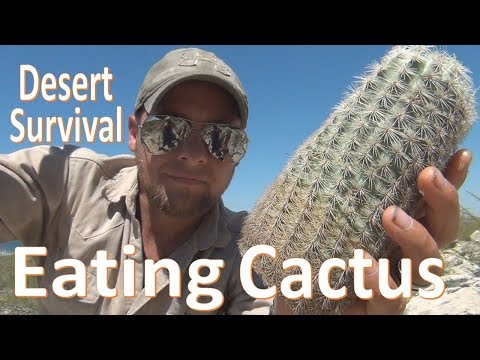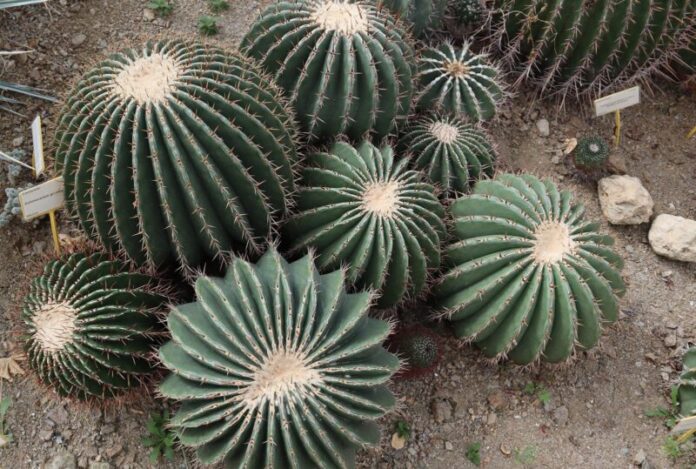Cacti thrive in hot and dry regions but can be found all over the world in areas that don’t reach below freezing. While admiring the vicious-looking appearance, you might be surprised to learn that it offers much in terms of survival.

Yes, you can eat most cacti, though some varieties are toxic for humans. Generally, eating the fruit and pads raw or cooked won’t cause you harm.
Cacti fruit can provide hydration, nutrients, and minerals in a survival situation.
All fruits of a true cactus are edible and sometimes you can eat the entire plant without side effects. Learning how to identify and prepare cacti is an important skill that can save your life.
Let’s take a deeper look at how you can utilize this unique plant in a survival situation.
Are All Cacti Edible?
The majority of cacti species are not edible, but the edible species are easily found and highly sought after due to their amazing health benefits.
Edible Parts
All edible cacti species bear fruit that grows at the tip of an arm, or on the top of the plant.
The fruit on all true cacti is edible, and can be enjoyed either raw or cooked after some preparation.
The pads on some edible cacti, like the prickly pear, and leaves like the cholla are edible and can also be enjoyed raw or cooked after minor preparation.
What Parts Are Toxic?
With any edible plant, there is always a risk when eating large quantities due to the minute traces of toxins.
An edible cactus plant does not have toxic parts that should be avoided, it does however have parts that taste extremely unpleasant.
Most cacti species contain oxalic acid which is toxic to us humans. When ingested, oxalic acid reacts with the calcium in our bodies and produces calcium oxalates.
Eating edible cacti will rarely make you sick unless you have eaten too much.
What Common Cactus Plants Are Edible?
Dragon fruit and prickly pears are common enough to be found in your supermarket, but you will also find them growing wild in warmer regions of the world.
There are more edible cactus species out there in the wild that can help you survive.
Dragon Fruit
Wild red dragon fruit looks like the ones found in your supermarket and can be eaten from harvest, yellow dragon fruit has spikes that need to be removed before eating. You will find these fruits hanging from the tips of the leaves on the very tall plant.
Cut the fruit in half to eat the white center with black seeds, you’ll find it has a mild, sweet-to-sour taste.
This plant will help boost your immune system and when you’re dehydrated and low on energy this fruit is there to save you.
Barrel Cactus
Be careful harvesting this plant! A barrel cactus is a spiked ball, as tall as three meters in some regions. If you come across one you can look down on, you can find it topped with fruit.
The fruit looks like miniature pineapples with a dried flower on top.
Avoiding all spike clusters, carefully grab the yellow fruit and twist it off, cut it open and eat the tangy lemon-tasting insides.
The fruit of a barrel cactus will provide you with vitamins A and C.
Prickly Pear Cactus
The best part about the prickly pear cactus is you can eat both the fruit and the pads. You will find multiple yellow to red fruits (aka tunas) around the edges of the pads.
Carefully break off a pad loaded with fruit, cut open fruit, and eat the red seeds inside. You can also eat slices of the pad.
Before consuming, scrape off the skin of both the fruit and the pad to remove little hairs and spikes. Eating too many of the cacti pads may cause an upset stomach.
Saguaro Cactus
This is a cactus protected by law in Arizona but when you are in a survival situation, your life comes first.
The green to red egg-shaped fruit is found at the tip of the 20 ft tall arms with a dried flower sticking out of the top.
It’s difficult to reach but if you can find a dead saguaro cactus around you they make a great harvesting tool.
Cut open the fruit and eat the seeded tangy insides to get the benefits this fruit offers. It will also provide you with hydration immediately after you eat it.
Cholla Cactus
The Cholla cactus is almost not worth harvesting due to the risk of injury, but if it’s necessary, the fruit is edible. Protect yourself from the spikes before going in.
The small yellow to red fruit is covered in spikes. The fruit is located at the tip of a long arm, which is also covered in spikes that will stick to you when touched.
Using tongs, grasp the fruit and twist it to break it off. Scrape off the spines or burn them off over a fire before consuming.
Chia Sage
The Chia sage is an entirely edible plant and looks nothing like your typical cacti.
It can grow in bushes or as a single plant up to two feet sprouting a tall stalk topped by a spiked ball with miniature purple flowers, while the leaves from the ground look like dandelion leaves.
The seeds from this plant, also known as Chia Pet Seeds, are highly nutritious and will give you a nice burst of energy after eating.
Agave
Agave looks like an aloe plant with a tall tree in the center. The color of the plant ranges from blue to vibrant and dark green and the fruit is found at the very top of the tall tree.
The entire agave plant is edible. Due to the dry qualities of agave, the plant is usually boiled before being eaten, however, you can eat the buds while they are still soft.
If your priority is calorie intake this is the cactus to seek. There are more calories in a cup of agave than there are in a large pepperoni pizza.
How to Harvest and Eat Cactus in a Survival Situation
There are a few techniques for harvesting and eating cacti but when you’re in a survival situation only a few of those techniques are useful.
You’ll want to harvest quickly, but it must be done safely as the spines can be painful on most varieties.

Harvesting
When harvesting cacti you’ll need protection from their hairs and spikes, this might include arm and hand coverage, body coverage, long-reaching tools, or tongs to get the fruit.
To harvest the fruit you’ll need to twist the fruit for it to fall off, having it fall to the ground is better than catching it when the fruit carries spikes.
To harvest cactus pads, you’ll need to grasp the pad and pull it against the direction of growth to break it off or use a knife to cut it off.
Cooked Vs. Raw
Every part of a cactus that’s edible can be eaten raw or cooked. In a survival situation eating the cactus raw is your best option which simply requires cutting it open and eating the insides.
Eating cactus raw requires less prep time and you’re getting all the nutrients.
Another option is roasting the seeds, pads, or fruit over a fire for a warm dish. Your other option is to boil it in water or soup.
These are great options to avoid any potential toxicity or to warm yourself up.
Benefits of Eating Cactus
Cacti are used medicinally not only internally, but externally. The fruit of cacti is found in health food markets and is a delicacy in high-nutrient diets.
Don’t look past this plant when you need energy, protein, carbs, and hydration.
Average Calories
The average calories per cup of cacti are roughly 200. This measurement ranges from 40 calories to a staggering 680+ calories, with prickly pears being one of the lowest and agave being the highest.
Considering the average adult needs 2,000-2,500 calories a day, one cup of cacti calories will last long enough to keep you going for one hour.
Minerals and Nutrients
All parts of a cactus plant are loaded with vitamins, minerals, and nutrients. Some nutrients are unique to certain cacti species while most are common throughout all species.
Let’s break it down so you know what you’re feeding your body:
| Prickly Pear Cactus | Vitamin C Vitamin B6 Magnesium Calcium |
| Dragon Fruit | Antioxidants Vitamin C Iron Magnesium |
| Saguaro Cactus | Vitamin B12 Vitamin C Fiber Protein |
| Cholla Cactus | Omega-3 fatty acids Protein Antioxidants Fiber |
Edible Cacti FAQ
Many questions are brought up when it comes to eating cacti. Here’s a quick one-stop for the frequently asked questions on eating cacti.
Is eating raw cactus good for you?
Eating raw cactus is great for you. Be sure you’re eating the appropriate species to avoid toxicity and an upset stomach.
Can I drink water from a cactus?
Yes, you can drink cactus water. Don’t drink in large quantities as it may cause an upset stomach.
What cacti are not edible?
The San Pedro, Bolivian, and Peyote species are all non-edible varieties due to the alkaloids found within.


